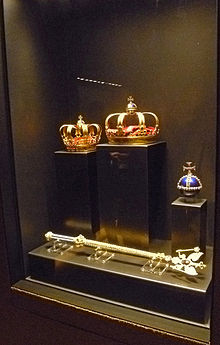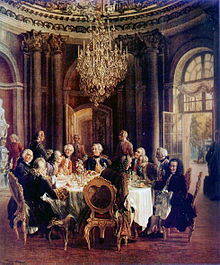King in Prussia
![]()
The title of this article is ambiguous. For other meanings, see King of Prussia (disambiguation).
The King of Prussia (until 1772 King in Prussia) was the head of state of the Prussian monarchy, which existed from 1701 until the November Revolution of 1918. During the years of the German Empire, the Prussian king was also German Emperor from 1871.
The first kings bore the title "King in Prussia", to which the Elector Frederick III of Brandenburg and at the same time sovereign duke in the Duchy of Prussia, which did not belong to the Holy Roman Empire, was the first to be crowned on 18 January 1701. The restrictive titulature "in Prussia" was necessary because the designation of could have been understood as a claim to the entire territory of Prussia, the western part of which belonged to the Kingdom of Poland as Prussia of royal share.
In 1700, after lengthy negotiations, the Roman-German Emperor Leopold I had concluded a treaty with the Elector of Brandenburg concerning the intended coronation of Frederick III of Brandenburg as king. In this treaty he promised to recognise the Elector and his successors as one king, both within and outside the empire, just as he had hitherto recognised the kings of Sweden, Poland and Denmark. Although the coronation took place in Königsberg, Berlin and Potsdam remained the centres of the Prussian state as the capital and preferred residence of the kings.
In the course of the 18th century, the Duchy, now "Kingdom of Prussia", became the name for all territories of the King of Prussia. The name Prussia became common in Germany and Europe for all territories ruled by the Hohenzollerns of Brandenburg - whether located within or outside the Holy Roman Empire. After the annexation of Prussia's royal share, the title changed to "King of Prussia" in 1772.
By enacting a constitution as a result of the March Revolution of 1848, the King of Prussia changed from an absolute to a constitutional monarch. He chose the ministers; no law could be passed without his consent. After the Emperor of Austria, the King of Prussia was the most important monarch in the German Confederation from 1815.
In 1867, the constitution of the North German Confederation gave the king the federal presidency in the newly founded federal state. Thus he was in personal union always king and at the same time head of state of the German federal state. In addition, on 1 January 1871, the new constitution gave him the title German Emperor.
There was an acting king until 9 November 1918, when Reich Chancellor Max von Baden arbitrarily announced the abdication of the Emperor and King Wilhelm II (as well as the Crown Prince). Wilhelm himself did not actually abdicate until 28 November. Prussia became a Free State of Prussia at the latest with the new republican constitution of 1920.

The Prussian Crown Jewels of Frederick I, today on display in Charlottenburg Palace
Coronation 1701
→ Main article: Royal coronation of Frederick III of Brandenburg
In 1701 the Habsburg Leopold I was in urgent need of the military help of Brandenburg-Prussia in the War of the Spanish Succession. Thus he was prepared to recognise a royal crown for the Elector. In the corresponding agreement between Vienna and Berlin, at Frederick's insistence, the formula that the Emperor crown the Elector or create the Prussian crown was deliberately omitted. The crown treaty of 17 November 1700 was signed by the Emperor only after the Elector had entered into an alliance with him. The Emperor promised that he would work for the recognition of the new royal title also in the Empire and with other powers.
The Elector was anxious that his crown should express his unlimited sovereignty. The Prussian estates were not consulted and were only informed in December 1700 that there would be a coronation feast. For the coronation act on 17 January 1701 Frederick made use of various European traditions. He put the crown on himself, after which he had himself anointed by the Calvinist bishop. It is estimated that the coronation festivities cost the state about twice as much as the Hohenzollerns earned annually. With one exception, Frederick's successors dispensed with expensive and pompous coronation ceremonies.

Pictorial representation of the royal coronation in Königsberg in 1701
Development until 1848
The second king in Prussia, Frederick William I, united the Prussian administrative tops in the General Directorate, and he further restricted the privileges of the estates. He surrounded himself with a personal circle of advisors, the Tobacco College.
Frederick II (from 1740), on the other hand, destroyed the uniformity of state governance by establishing new authorities alongside the Directorate-General and assigning individual tasks to commissioners. Moreover, he no longer presided over the Directorate-General in person, but communicated with the ministers in writing. He ruled "from the cabinet," his private chambers, through cabinet secretaries, who thus gained great influence. They could overturn all the ministers' decisions.
The new King Frederick William II therefore issued an instruction on 28 September 1786 prescribing weekly plenary sessions. However, the basic problem remained that thematic and regional responsibilities existed side by side on an equal footing. Under Frederick William III. (from 1797) a certain improvement occurred in that the heads of departments and their portfolios became de facto more independent. However, this was not yet formally a collegial ministerial government.
In the period following the defeat by France in 1807, the Stein-Hardenberg reforms took place. An Edict of Organization of 1808 created a ministerial government. Ministers were given direct access to the king; the king's orders required a ministerial countersignature. In the years 1810-1822 Prussia under Hardenberg had a chancellor as senior head of government; otherwise the government was collegial.
Stein's plan for the Council of State was unsuccessful. The Council of State would have been responsible for legislation and, among other things, would have controlled the administration (in this respect comparable to a parliament). The king would have presided, but his self-government would have been further restricted. In fact, the Council of State met for its first session in 1817, but only as an advisory body. Its members were appointed by the king or were members by birth, like the king's sons, or by office, like the chancellor. In practice, however, the Council of State had the greatest influence because it was knowledgeable and acted independently and responsibly.
Despite repeated promises, the king did not issue a constitution and did not establish a Prussian parliament, only provincial estates. Thus the Prussian monarchy remained a late absolutist or semi-absolutist state. Despite hopes to the contrary in 1840, Frederick William IV did not appoint a senior head of government or fulfill his predecessor's constitutional promise. It remained with the unreal idea that in the 19th century a king could continue to lead a personal regiment as in the times of Frederick the Great.

Adolph von Menzel: King Frederick II's Round Table, painting from 1850
Questions and Answers
Q: What was the title used by the rulers of Prussia from 1702 to 1772?
A: The title used by the rulers of Prussia from 1702 to 1772 was King in Prussia.
Q: Why did the rulers of Prussia want to be Kings?
A: The rulers of Prussia, who were also Princes and Margraves of Brandenburg, wanted to be Kings.
Q: Why did the Holy Roman Emperor not allow them the title of King?
A: The Holy Roman Emperor did not allow them the title of King.
Q: What did Emperor Leopold I allow Frederick to call himself?
A: Emperor Leopold I allowed Frederick to call himself King in Prussia.
Q: Was Frederick only regarded as King outside the Empire?
A: Yes, Frederick was only regarded as King outside the Empire.
Q: In 1772, what did Frederick II annex and what did he decide to call himself?
A: In 1772, Frederick II annexed most of Poland and decided to call himself King of Prussia.
Q: When did the Holy Roman Empire cease to exist?
A: The Holy Roman Empire ceased to exist in 1806.
Search within the encyclopedia